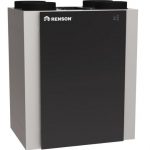What is the MVHR system
We need a healthy indoor environment to live a happy and healthy life. In a modern energy-efficient building we need ventilation to achieve this. Why we do need ventilation you can read
here.
How does a MVHR system work?
An MVHR unit (Mechanical Ventilation with Heat Recovery or simply Heat Recovery unit) provides fresh filtered air into our homes (habitable rooms and bedrooms) whilst extracting the polluted air from the wet rooms such as kitchen, WC, bathrooms and utility rooms. During this cycle, the MVHR heat exchanger recovers the heat from the warm and humid air without mixing the fresh air with the polluted air. The exchanger is made of thin aluminium or plastic plates or from ceramic. In a plate heat exchanger you find many thin Aluminium/plastic plates. Between the plates there are a small gaps, for the supply and return air. One gap the air is leaving and in the next gap the air comes in. The heat is transferred to the other side of the plate so the warm air heats up the incoming cold air. There are some other solutions like to rotary wheel or the single room heat recovery but majority of the systems work with plate exchanger. The rotation wheel exchanger is a large metallic wheel slowly rotates around the MVHR unit fresh/exhaust air side and transfer the heat while rotates from one side to the other side. The single room heat recovery units change the airflow direction every few seconds and during the exhaust cycle a ceramic insert heats up and when the airflow changes the inert heats up the incoming cold air.
Why choose an MVHR unit.
Homes account for over 15% of the greenhouse gas emissions, and we must lower these emissions if we are planning on living long on this planet.
Our buildings become increasingly airtight, with better insulation, better windows, better building methods, but this means the pollution we “produce” trapped inside. Whilst we are on a good track with improving our buildings this has created another problem and this is bad Indoor Air Quality. Many of those pollutants cause health problems or even damage our buildings. MVHR units improve the Indoor Air Quality by not wasting energy & recovering up to 95% of the energy that would otherwise be lost. MVHR units are one of the few systems available today that filters the incoming air. So even if you live in a polluted area, we can filter the dust, pollens, bacteria, or even nitrogen from the incoming air.
MVHR units are ideal for newly built homes, constantly occupied homes, large homes and for people with an active life.
Good for our health, good for our wallet and good for our planet.
What kind of MVHR units we offer
Single room or decentralised MVHR units
“Nomen est omen”, the single room MVHR units designed to continuously ventilate one single room. They are ideal for renovation, holiday homes, replacing existing bathroom fans or if we have difficulties in installing ducting to a room. They are installed through the walls, extract the air from the room and they supply the air to the same room. Single room MVHR units look like a bathroom fan, but most of the time they equipped with better controls and operate with a lower noise levels. It acts as a breathing lung in the room, alternating between supply & extract , recovering the heat from the extract air as it does so. There is a ceramics core in the unit, the warm air extracted from the room, heats up the core and when the cycle changes the fresh air is coming back, the core heats up the incoming air.
Whole house MVHR units
Whole house centralised systems are installed in the attic, technical room or utility room and it`s ducted to the bedroom, living rooms and wet rooms. The filter is located at the unit, so access is important for maintenance.
A good MVHR system is installed on a manifold system providing fresh air to the habitable rooms, bedrooms, living room and exhaust the polluted air from the wet rooms such as kitchen, wc, bathroom, utility room or any other room where you expect pollution. Each room is ducted individually, and this keeps the system quiet and stops any "cross-talk" within the system.
The most important part of any MVHR system is the fan sizing, it is vital to get this right, as a unit that is too small for the dwelling will be loud and inefficient. Manufacturers recomend the unit should not run on more than 50% capacity in normal running mode.
Whole house i-MVHR units
i-ventilation believes in demand-controlled systems. In the 21st century, we have all AI and sensor technology to improve the average systems for something better. Our i-MVHR range detects pollution such as humidity, Co2, VOC, smell. This means our range of whole-house i-MVHR systems use less energy, they are more efficient and they are less noisy. In other words, they are simply better.
Check our passive house certified i-MVHR units:

 Safe & Secure Shopping
Safe & Secure Shopping Fast and Reliable Delivery
Fast and Reliable Delivery Excellent Friendly Services
Excellent Friendly Services
